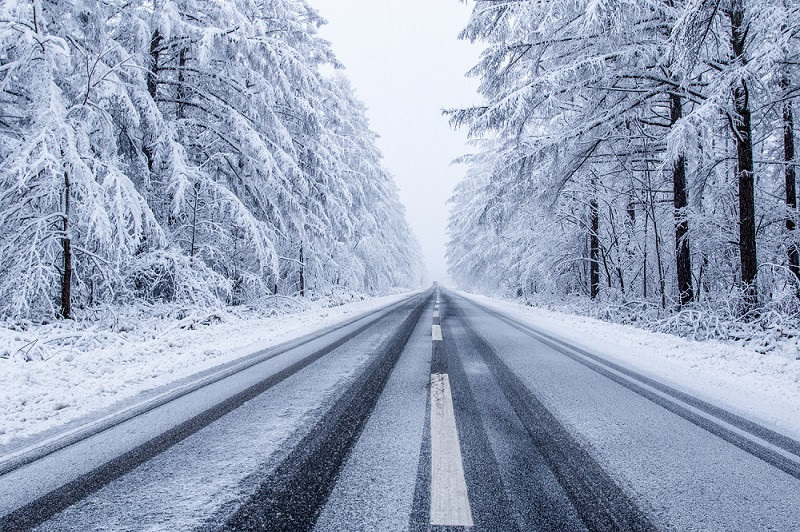When cold weather blows in, new Environment, Health, and Safety (EHS) concerns follow thanks to the changing weather landscape. Are you prepared for wintery conditions when you’re on the job? Here are five things to keep in mind as we enter the coldest months of the year.
1. Drive with Care
It’s no secret that winter weather brings a whole host of new challenges to your everyday life, including your work life. Much of the country sees snow, freezing temperatures, and icy conditions for months at a time. Snowstorms can appear quickly, and they can rapidly change as they move east. You may see a forecast for a light dusting of snow, only to walk out and find several inches of snow on your vehicle. That’s why it’s so important to be prepared for winter hazards and conditions.
Remember that the roads will be icier and less safe than usual. Even on a perfectly dry day, patches of black ice can catch you unaware. The best thing you can do when driving is stay alert, go slow, and be careful. Accelerate and decelerate slowly and leave plenty of space between you and the vehicle in front of you.
Winter also brings low light conditions with the sun setting much earlier than it does in the summer. This can decrease visibility, bring on more sunlight glare, and leave you feeling more tired than usual, slowing your reaction time. During the winter months, drive slower, assume other drivers can’t see you, and stay alert. Don’t drive when you’re tired if you can avoid it. If you’re working outside in the afternoon and it’s getting dark, consider wearing reflective clothing and bringing a flashlight with you.
Speaking of bringing supplies with you, AAA recommends packing a bundle of cold-weather gear in your car during the wintertime. That way, if you get stuck somewhere, you have extra supplies. A cold weather kit can include things such as extra food and water, a flashlight, warm clothing like gloves, boots, and hats, a blanket, a shovel, a glass scraper for your car, and more.
2. Keep Yourself Safe and Warm
Cold weather shouldn’t be taken lightly. Bundle up with several layers of loose clothing for insulation, choose waterproof gear, ensure you wear a hat or insulated hard-hat liner outside to reduce loss of body heat and make sure your work boots are insulated and waterproof. Also, wear boots with good tread and use ice cleats for ice-covered or snow-packed surfaces. Your work gloves should be fitted to keep the cold and wet out without restricting your hand movements; also consider hand and foot warmers for extreme cold. When working outdoors, it's good practice to keep a change of clothing in your vehicle in case you get wet.
Without proper gear, frostbite can set in fast. Frostbite happens when a part of your skin and the underlying tissues freeze, and it can cause permanent damage if you’re not aware and careful. That’s why covering areas of your body that are most prone to freezing such as your nose, toes, fingers, ears, and more is so crucial.
If a worker displays symptoms of frostbite, move them into a warm room as soon as possible. Don’t allow the worker to keep walking on frostbitten feet or toes, as that can cause more damage. Use warm (not hot) water at around 100–105 degree Fahrenheit to rewarm the parts of the body that are affected. The best way to take care of frostbite is to prevent it from happening in the first place with proper gear and going inside when it’s too cold.
Hypothermia is another condition winter can bring, and again, prevention is important. However, if a worker gets too cold too quickly and is outside in cold temperatures for a prolonged period of time, it’s time to take action. Get them out of the cold, wet weather, and into a warm room or vehicle. To prevent hypothermia, use the right gear and watch for warning signs in your coworkers and yourself such as impaired speech, lack of coordination, and uncontrollable shivering. Again, bundle up, because preventing hypothermia is easier than curing it.
Finally, remember that even when you're cold while working outside, staying hydrated is still important. With the winter air being colder and drier, sweat evaporates faster, which can make it less obvious you're losing fluids. This can lead to dehydration, as you won't notice the sweat the way you would in warm temperatures. Be sure to drink warm liquids while on the job site to stave off dehydration and to stay safe.
3. Use Extra Caution on a Job Site
Schedule work to accommodate the weather conditions, including taking note of incoming storms. Plan your travel to and from the site and plan your activities at the worksite. Evaluate whether walking or driving is the safer way to traverse the site. Use salt, ice melt, or sand to improve your traction as you move around. Also, be sure to use the buddy system when possible so you can monitor each other for signs of cold stress. Take breaks in a warm, dry location, even if it’s just your vehicle.
Always evaluate the weather conditions. Is it safe to work? If conditions change and you feel it is no longer safe, Use Stop Work Authority and notify your manager.
4. Slips and Falls
In the winter, it’s important to watch out for ice, snow-covered ice, black ice, and uneven surfaces. All of these things can cause you to slip and fall, which can lead to injury on the job. Always scan the area ahead of you as you walk, and consciously decide the best path to take that avoids most of these hazards. Also, be sure your path is clear of obstacles. Defense walking is your best bet to avoid slipping or falling.
As your last line of defense, you can do the Penguin Shuffle on icy surfaces. Here’s a quick rundown of how to do the Penguin Shuffle:
- Point your feet out like a penguin and spread them out slightly while walking to stabilize your center of gravity.
- Bend slightly and walk flat-footed with your center of gravity over the front leg as much as possible.
- Keep your hands out of your pockets and keep your arms at your sides to maintain balance.
- Take short steps or shuffle for stability. Try to shorten your stride and walk slowly to navigate the ice.
Remember, defensive walking and the Penguin shuffle can help you stay safe and injury free this winter. Always be conscious and cautious while walking outside.
5. CO Hazards
Carbon Monoxide (CO) poisoning can be fatal, and incidents of CO exposure go up during the wintertime thanks to running vehicles inside or in partially ventilated areas. In fact, the CDC reports that approximately 50,000 people in the US visit the emergency room each year due to accidental CO poisoning. That’s why it’s so important to take steps to ensure you and your team aren’t putting yourself in danger of CO poisoning.
For example, don’t warm up any vehicle in a closed garage or building space. Also, when using fuel-burning equipment, be sure it’s in a well-ventilated area with effective ventilation systems in place if you have to use this equipment inside. You can also utilize CO detectors to help keep you safe where CO hazards exist. Finally, be sure you and your coworkers avoid using any fuel-burning equipment in an enclosed or partially enclosed space.
What About the Rest of the US?
Okay, what if you don’t live in an area that sees snow, ice, and winter temperatures? Unfortunately, winter doesn’t mean you can let your guard down. Late season tornados and strong storms are becoming more common due to the warming of the planet from climate change. It’s important to always have an evacuation or shelter-in-place plan updated and available for your whole team to see, and to go over that procedure with your team so that you all know what to do in the event of a late season tornado.
Of course, another thing to be aware of is that temperatures will naturally be colder. So, while you probably won’t have to deal with freezing temperatures, you still should dress in loose layers to stay warm. Your body won’t be used to the colder temperatures right away. If it warms up throughout the day, you can easily shed some layers to stay comfortable. Winter also can bring more rainfall to parts of the US that don’t see snow, so being aware of the weather should still be part of your daily routine.
Hello, Winter
Winter weather brings on all sorts of potential threats. But, you can also view it as an opportunity to drive EHS renewal at your organization. Whether it’s cold temperatures, icy roads, or anything in between, staying alert and safe is key for everyone.
Need help improving your EHS culture? Learn more about our health and safety consulting services.
Want more news and insights like this?
Sign up for our monthly e-newsletter, The New Leaf. Our goal is to keep you updated, educated, and even a bit entertained as it relates to all things EHS and sustainability.
Have any questions?
Contact us to discuss your environment, health, safety, and sustainability needs today.





